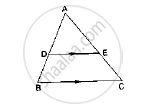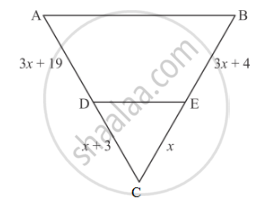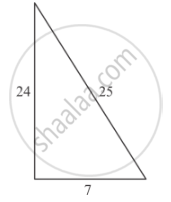Advertisements
Advertisements
Question
In ∆ABC, points P and Q are on CA and CB, respectively such that CA = 16 cm, CP = 10 cm, CB = 30 cm and CQ = 25 cm. Is PQ || AB?
Solution
Given: `AC=16cm,CP=10cm,CB=30cm` and `CQ=25cm`, we get
We will check whether `(CP)/(AC)=(CQ)/(BC)` or not to conclude whether `PQ||AB`.
`(CP)/(AC)=(10cm)/(16cm)=5/8`
`(CQ)/(CB)=(25cm)/(30cm)=5/6`
`∴ (CP)/(AC)≠ (CQ)/(CB)`
Hence, PQ is not parallel to AB.
APPEARS IN
RELATED QUESTIONS
In below Figure, ΔABC is right angled at C and DE ⊥ AB. Prove that ΔABC ~ ΔADE and Hence find the lengths of AE and DE.

D and E are points on the sides AB and AC respectively of a ΔABC such that DE║BC
If AD = 3.6cm, AB = 10cm and AE = 4.5cm, find EC and AC.

D and E are points on the sides AB and AC respectively of a ΔABC. In each of the following cases, determine whether DE║BC or not.
AB = 11.7cm, AC = 11.2cm, BD = 6.5cm and AE = 4.2cm.
What values of x will make DE || AB in the given figure?

In the given figure, DE || BD. Determine AC and AE.

In each of the following figures, you find who triangles. Indicate whether the triangles are similar. Give reasons in support of your answer.

There is a staircase as shown in the given figure, connecting points A and B. Measurements of steps are marked in the figure. Find the straight line distance between A and B.

In the figure given below DE || BC. If AD = 2.4 cm, DB = 3.6 cm, AC = 5 cm. Find AE.
∆ABC is a right triangle right-angled at A and AD ⊥ BC. Then, \[\frac{BD}{DC} =\]
In a right triangle ABC right-angled at B, if P and Q are points on the sides AB and AC respectively, then
